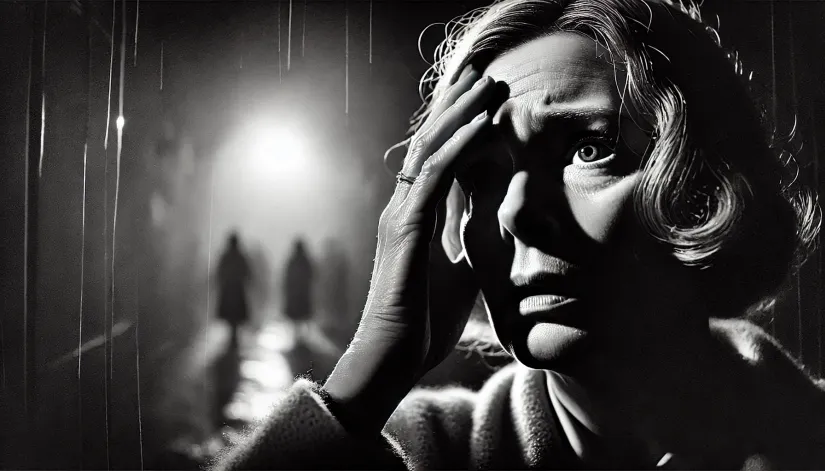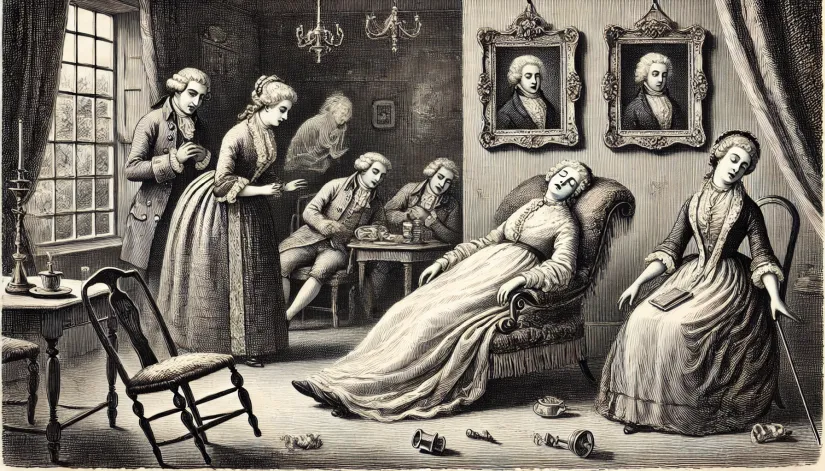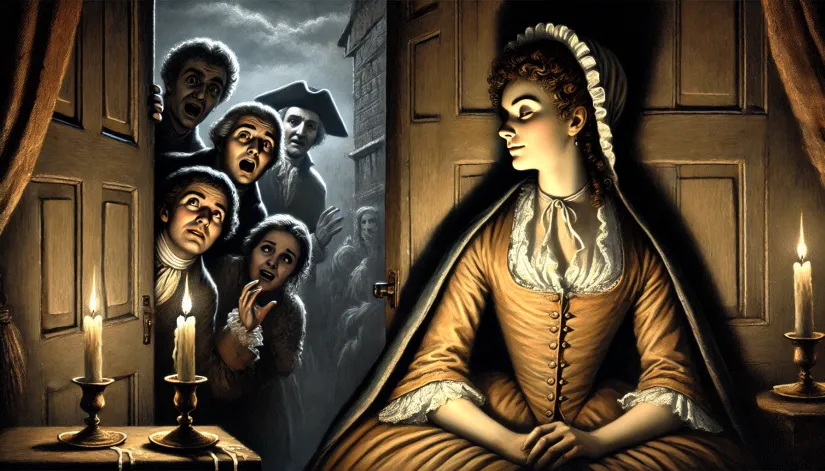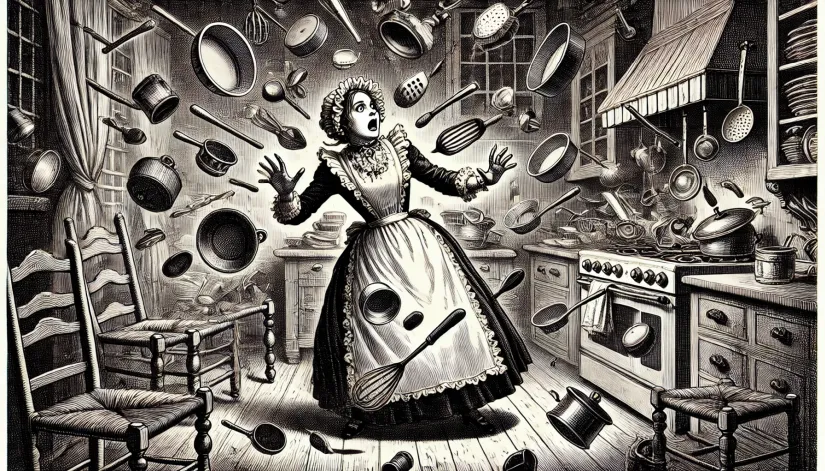The Stockwell Poltergeist (the Stockwell Ghost) is one of the most intriguing paranormal stories of the 18th century. This bizarre incident happened in Stockwell, a small village just outside London, back in January 1772.
It started with unexplained disturbances in the home of a well-respected widow. However, it soon grew into a full-blown poltergeist: moving furniture, cups, and saucers rattled down the chimney, pots and pans whirled down the stairs (or through the windows), and hams, cheeses, and loaves of bread disported themselves upon the floor as if the devil were in them.
Everyone was in shock. For years, folks around Stockwell were convinced the strange events in Mrs. Golding’s house were caused by poltergeist activity or witchcraft. That is, until a shocking confession in 1825 revealed the real story.
In this article:
Setting and Background
In the late 18th century, Stockwell was a quiet rural hamlet in Surrey, far removed from the hustle and bustle of central London. The village was picturesque, with rolling fields, shady lanes lined with hedgerows, and fewer than a hundred cottages clustered around a village green.
Sheep ambled across the green, while sparrows and yellowhammers darted through the sky. Life here was simple. Families relied heavily on one another, sharing their joys and their hardships. The village was largely agricultural, with people working the land and tending to their small gardens.
Related: Mackenzie Poltergeist: Is Greyfriars the World’s Most Haunted Graveyard?
However, back then, belief in ghosts, witchcraft, and other supernatural forces was common—especially in small rural communities like Stockwell. Many believed in spirits (both good and bad) that could interfere with everyday life.
So, it wasn’t unusual for folks to blame strange happenings on witchcraft or ghosts since science hadn’t yet explained many of life’s mysteries. With all this superstition swirling around, Stockwell was more than ready for the tale of the Stockwell ghost.

Mrs. Sarah Golding was the primary victim of the Stockwell Poltergeist. Disturbances followed her wherever she fled, causing such intense fear and exhaustion that even medical help failed to bring relief—culminating in the eerie shattering of a bloodletting bowl during treatment.
The Main Characters
At the story’s center was Mrs. Sarah Golding, a well-respected widow known for her kindness and generosity. She lived comfortably in her Stockwell cottage, which sat close to the Tower public house and was surrounded by a small garden.
Mrs. Golding was trusted by her neighbors, and she had a reputation for being devout and caring. She was not the kind of person anyone would expect to find at the center of a supernatural mystery. Which, when it happened, only made the entire thing more bewildering for the community as a whole.
Ann Robinson—Mrs. Golding’s servant—was another key figure in the drama. Ann was a young woman, about twenty years old, who had only been working for Mrs. Golding for a week when the alleged disturbances began.
Related: Meet the Spirits: Are the Winchester Mystery House Ghosts Real?
At first, people sympathized with Ann. She was just another victim of the strange occurrences, right? To everyone else, she was just as terrified and confused as Mrs. Golding. And her reactions seemed genuine.
Finally, we have William Hone, a well-known author and journalist who later documented the truth behind the events. Hone’s careful research included interviews, witness testimonies, and personal observations. He was the first to figure out what was actually happening in Mrs. Golding’s house.

The Stockwell Poltergeist
As I mentioned above, everything started in January 1772. On January 6, to be more exact.
According to reports, Ann Robinson burst into the parlor that morning, shouting that the kitchen was being turned upside down by unseen hands.
Alarmed, Mrs. Golding followed Ann to the kitchen, and to her utter shock, she saw cups and saucers rattling down the chimney, pots and pans being hurled down the stairs, and loaves of bread rolling across the floor as if they had a life of their own.
The infamous Stockwell Poltergeist had begun its notorious reign.
Things escalated quickly. A clock fell and shattered, a lantern hanging on the staircase was thrown down, and an earthen pan of salted beef hit the ground, scattering its contents everywhere.
Neighbors heard the commotion and rushed over. They found Mrs. Golding in shock.
Fearing her entire house might collapse, Mrs. Golding called on Mr. Rowlidge, a local carpenter, to inspect the building.
After a close inspection of the house, Mr. Rowlidge concluded that the disturbances were likely due to the weight of an extra room added to the upper floor. He recommended immediate evacuation.
SpookySight recommends: Who Is the White Lady of Hohenzollern Castle?
Overwhelmed and fearing that she might have to leave her home, Mrs. Golding fainted and had to be carried to her neighbor Mr. Gresham’s home for shelter.
Meanwhile, some of the neighbors noticed something strange about Ann Robinson. Despite everything happening in and around the house, the maid was unusually calm and unconcerned.
Interestingly, once at Mr. Gresham’s home, the chaos didn’t stop. Mrs. Golding was so frightened that a surgeon, Mr. Gardner from Clapham, was called in to help her. He let her blood, hoping to relieve her distress.
But then something even weirder happened. The blood itself became a target of the mysterious Stockwell ghost—jumping out of the bowl and shattering it on the ground. Everyone was convinced that the entity was somehow targeting Mrs. Golding. Not the house.
Things got even worse for Mrs. Golding as the disturbances seemed to follow her wherever she went.
For instance, she found the few valuables she brought from her home to Mr. Gresham’s house thrown around all over the room. The next day, all Mr. Gresham’s expensive porcelain dishes crashed from the sideboard, smashing a large pier glass beneath it.
With chaos spreading to yet another household, Mrs. Golding fled to another neighbor, Mr. Mayling, hoping for peace.
But the Stockwell ghost wasn’t done. And the disturbances continued even here.
SpookySight recommends: The Anguished Man: Haunted Painting or Elaborate Hoax?
Eventually, Mrs. Golding took refuge with her niece, Mrs. Pain, at Rush Common near Brixton Causeway. Unfortunately, even here, she found no rest.
At Mrs. Pain’s home, things went from bad to worse. Interestingly, the pattern was very similar. Too similar.
Pewter dishes fell from shelves, rolled across the kitchen floor, and flipped over. Eggs flew across the room, striking a cat on the head and shattering. A pestle and mortar, candlesticks, brasses, glasses, and even a mustard pot began to move on their own. Hams and flitches of bacon hanging on the chimney weren’t spared either, flying as if some invisible force had taken hold of them.
Witnesses were terrified. Some ran away, sure that witchcraft or a devilish force was at work. But again, the main, Ann Robinson, stayed eerily calm. She flitted between rooms, never sitting still. She even tried to comfort Mrs. Golding, saying that these things couldn’t be helped.
However, her strange calmness and constant movement soon made others wonder if Ann herself might be behind the so-called Stockwell ghost.
Late that night, a certain Mr. Fowler was called in to stay with the frightened group. But even he couldn’t endure the eerie happenings and left at around 1 a.m. Mrs. Golding couldn’t sleep and eventually left her niece and moved to Mr. Fowler’s house, leaving Ann with Mrs. Pain.

Who Was the Stockwell Ghost?
Later that day, Ann returned to the Pain’s to help Mrs. Pain retrieve the children from a barn to where they had been evacuated. According to Hone’s notes, all was quiet at Mr. Fowler’s until the maid came back.
This “coincidence” only deepened suspicions that the Stockwell poltergeist and the maid were somehow connected. At this point, the mounting evidence against Ann Robinson was impossible to ignore.
SpookySight recommends: Who Is Resurrection Mary, Chicago’s Most Haunting Ghost?
Eventually, Mrs. Golding and her nephew-in-law, Mr. Pain, decided to set a trap. They sent Ann on an errand back to Rush Common, and during her absence, all paranormal activities stopped completely. When Ann returned, she was immediately dismissed.
And just like that, the chaos ended.
Mrs. Golding never experienced any disturbances again, confirming their belief that Ann had been behind the Stockwell ghost incidents all along.
A few years after the Stockwell poltergeist “incident,” Ann finally confessed to Reverend Brayfield (a local clergyman), admitting that she had staged the entire poltergeist act. She admitted using long horse hairs to move crockery, wires to manipulate objects, and even chemicals to make water seem like boiling.
In 1825, William Hone documented Ann’s confession in “The Every Day Book” (a popular publication of the time). Hone’s detailed account included witness interviews and evidence, revealing how Ann had tricked Mrs. Golding and the whole community.
In 1848, Catherine Crowe revitalized the whole ghost story in her book “Night-Side of Nature.” Just with a little twist: she “forgot” to cite the confession of a hoax that Hone documented. Instead, she presented the whole event as a genuine poltergeist incident. Very convenient.
Final Take
The strangest part of the Stockwell haunting was how many people believed it was real, even after doubts emerged.
In fact, even years later, some locals insisted the events were supernatural. Remember: all these happened in the 18th century, the age of Enlightenment, with thinkers like Hume and Voltaire challenging old beliefs.
Yet, despite rational progress, superstition still thrived, alongside movements like Wesley’s Methodism. But even John Wesley himself claimed to have experienced a poltergeist named “Old Jeffrey” at Epworth Rectory. So, I guess old beliefs die hard.
Related: Hinton Ampner Haunting: Restless Ghosts, Poltergeist, or Ancient Curse?
The case of the Stockwell ghost reminds us of the power of fear and the human tendency to believe in ghosts as justice-bringers (much like the Cock Lane Ghost). However, in Mrs. Golding’s case, she had much at stake—not just her china but her reputation, too.
And here’s another interesting angle: poltergeist activity often involves young girls. Why is that? Well, anthropologists suggest it might be an outlet for stress or conflict, especially for young servants under challenging circumstances.
Ann might have been a simple maid, but she certainly knew how to exploit people’s fears. And she wasn’t alone.
History has plenty of examples of servants tricking their masters—like the infamous Elizabeth Canning case or Mary Toft’s rabbit hoax, where both young women deceived those in authority.
Ultimately, Ann’s story and the infamous Stockwell poltergeist show us how the “lower classes” could use clever tricks to challenge those above them. And how some good old-fashioned mischief could still turn the world upside down.







